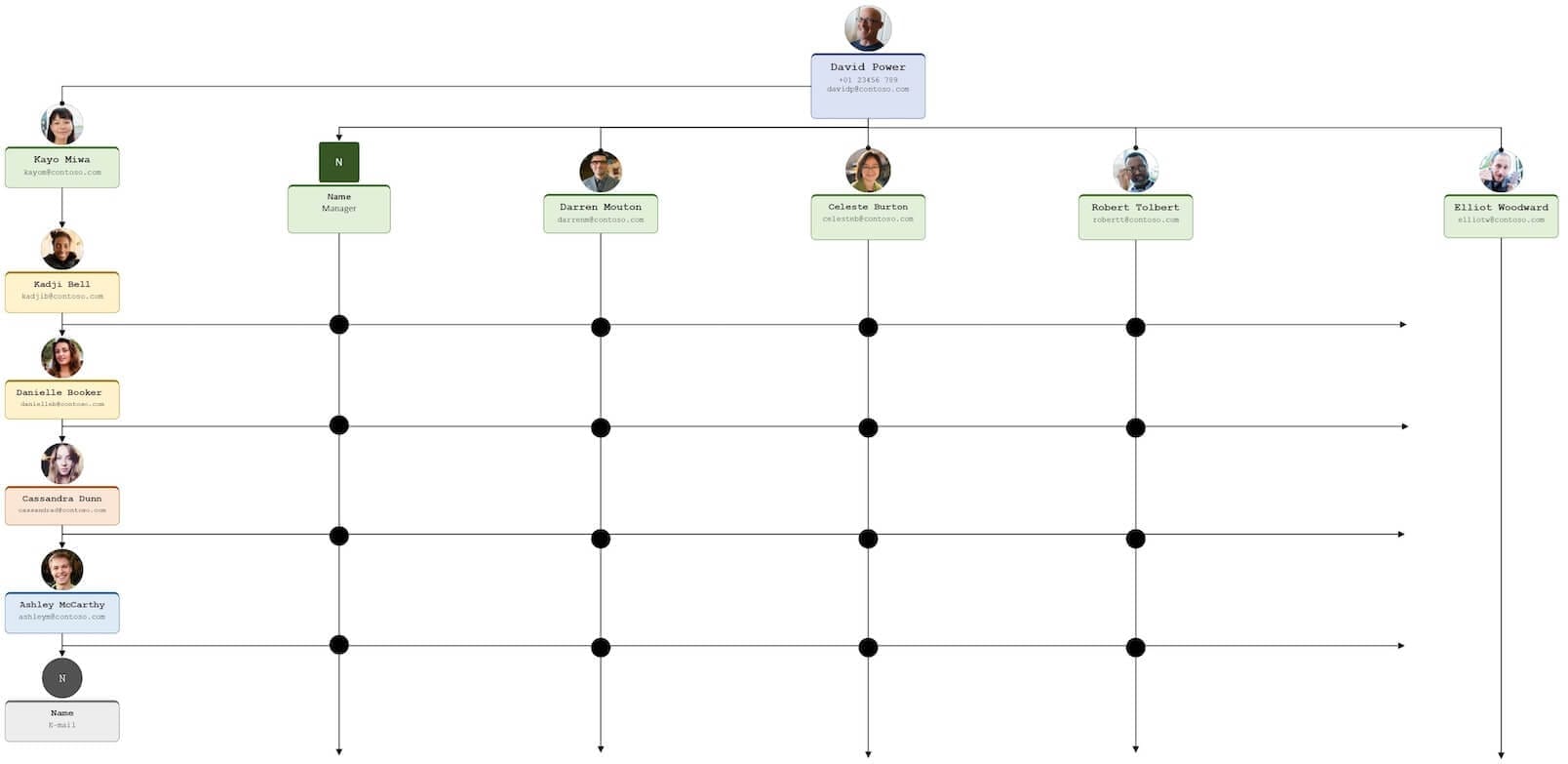Unravel the Hidden Power of the Matrix Organizational Structure
Let’s take a look at what exactly the matrix organizational structure is, where it came from, how it works, and its pros and cons.

The matrix organizational structure has been around for over four decades, and it's a favorite among businesses.
Why?
Because it strikes a unique balance between the traditional hierarchy-based organization and team-based collaboration.
So, let's unpack this a bit more.
What is a Matrix Organization?
The matrix organizational structure is a bit of a hybrid. It borrows features from both traditional hierarchy-based management and team collaboration. Picture it as a grid with two distinct axes: the vertical hierarchy and the horizontal teams.
The vertical axis is your typical top-down management that exists in most organizations. The horizontal axis, on the other hand, consists of teams organized according to project or product lines.
The result?
A unique blend of both traditional hierarchical management and team collaboration.

The Origins of the Matrix Organizational Structure
The matrix organizational structure started to take shape in the late 1960s. As companies began to expand and go global, they needed a new way to structure their teams. Enter the matrix organization, which allowed businesses to maintain control over multiple departments while still having one clear leader.
Fast forward to the 1970s and 1980s, when big players like IBM and Xerox adopted the matrix structure to manage their global operations more effectively. And with the advent of technology, implementing this type of organizational structure has become even easier. Thanks to software like Slack and Asana, team members can communicate more easily, making multiple reporting lines a breeze.
But it's not all sunshine and rainbows.
The matrix structure, while popular, does come with its challenges. Communication between teams can be tricky to manage, and it can lead to confusion about who's responsible for what.
Matrix Organizational Structure Advantages and Disadvantages
A matrixed organization offers numerous benefits as well as drawbacks. Below are the advantages and disadvantages to help you determine if this organizational structure is suitable for your business.
Advantages of a Matrix Organizational Structure
In the ever-changing business world, companies are always on the lookout for ways to maximize efficiency and increase profits. The matrix structure is one such way. It combines traditional functional and divisional structures, allowing for increased flexibility and improved collaboration.
- Delegation of Authority
The matrix org structure shines when it comes to delegating authority across multiple departments and divisions. This leads to more efficient decision-making and encourages collaboration between departments.
- Increased Efficiency
Matrix organizations are more efficient than traditional structures because they allow employees to specialize in specific tasks while still collaborating with other departments. This flexibility makes it easier for organizations to respond to changes in the marketplace.
- Improved Communication
Matrix organizations also improve communication between different departments. This makes it easier for employees to collaborate on projects and reach out for help when needed.
Disadvantages of a Matrix Organizational Structure
Matrix structures are one of the most popular types of organizational structures, but they have their drawbacks. In a matrix structure, individuals report to multiple managers instead of just one, and this can lead to confusion and miscommunication. Let’s take a look at some of the cons of a matrix organization structure.
- Complex Chain Of Command And Responsibility
The main problem with a matrix organizational structure is that it can be hard for employees to know who is responsible for what when it comes to decision-making. Since multiple people have authority over each project or area, determining who has the final say on certain matters can be complicated and lead to conflicts between managers. This can make things difficult for employees, who may not know whom to go to when they need help or advice.
- Lack Of Clear Goals
Another issue with a matrix organization is that goals may not be communicated clearly from the top down. With multiple managers involved in each project, communication about expectations and goals may become muddled or lost in translation. This can lead to confusion among employees and managers alike, which in turn affects productivity and morale.
- Difficulty With Performance Evaluation
Finally, performance evaluation becomes more difficult in a matrix structure since there are multiple people involved in each project. It can be difficult for managers to evaluate how well an employee is doing and if they should receive a raise or promotion if there is no clear consensus about their performance from all involved parties. This lack of clarity can lead to poor performance evaluations which can negatively impact morale and motivation among employees.
Types of Management for Matrix Organizational Structures
There are three main types of management for matrix structures. Each different type results in more or less authority to the team leaders or functional managers.
Let's have a look at the different types, seeing how authority shifts between team leaders and functional managers in each type:
The "Weak" Matrix Reporting Line
In a weak matrix structure, functional managers retain most of the power. Team leaders or project managers have limited decision-making autonomy and act more as coordinators. This can bottleneck communication as information gets lost between vertical and horizontal chains of command. Not ideal!
The "Balanced" Matrix Reporting Line
A balanced matrix organizational structure aims for an equal partnership between functional and team managers. Authority is shared, enabling collaboration and accountability. With open communication channels, project teams can progress smoothly under dual leadership. This equilibrium is the matrix structure "Goldilocks zone" that many aim for.
The "Strong" Matrix Reporting Line
Here team leaders and project managers wield greater authority, while functional managers take more of a backseat oversight role. Leadership is centralized around the project team for stronger ownership. The downside is that department heads lose influence over budgets, resources, and decisions.
So in summary, matrix organizational structures allow for versatile configurations of hierarchy. Where the balance of power lies determines how effectively project coordination and execution can occur. The "just right" balance depends hugely on the organization and its needs!
Top Alternatives to a Matrix Organizational Structure
Many alternative organizational structures to a matrix organization can be equally effective for certain types of businesses. Let’s take a look at some of the most popular alternatives.
The Functional Structure
The functional structure is one of the oldest and most common types of organizational structures. In this system, employees are grouped into teams based on their skill set or job description, with each team led by a manager who has expertise in that area.
This allows teams to specialize in their respective fields while still having access to resources and direction from higher-level managers. As such, it is well-suited for industries where teams need to work together to complete complex projects.

The Divisional Structure
The divisional structure is similar to the functional structure in that employees are organized according to their job duties or skill set.
However, unlike the functional structure, each division works independently and reports to its manager rather than working together on projects as part of one larger team. This makes it an ideal organizational model for companies with multiple products or services, as each division can focus on its unique offerings without being bogged down by cross-departmental issues or delays.
The Network Structure
The network structure is similar to both the functional and divisional models in that employees are organized according to their job roles or responsibilities.
However, unlike the other two models, which rely heavily on internal hierarchy and reporting structures, the network structure relies mostly on external relationships between departments (or even other companies). This makes it an ideal organizational model for companies looking to expand quickly or enter new markets without having to hire additional staff members.
Conclusion
The matrix organizational structure offers a flexible structure that combines the best of both hierarchical management structures and team collaboration models. By creating two distinct axes – one vertical for hierarchy
So, if you're looking to increase efficiency and productivity while minimizing risks associated with complex projects, you might want to consider implementing this type of organizational design.



